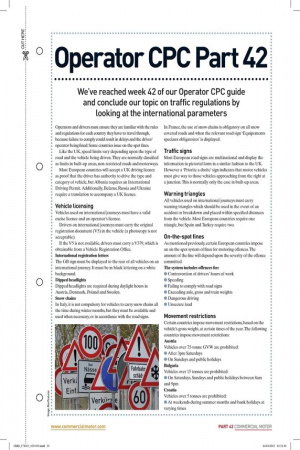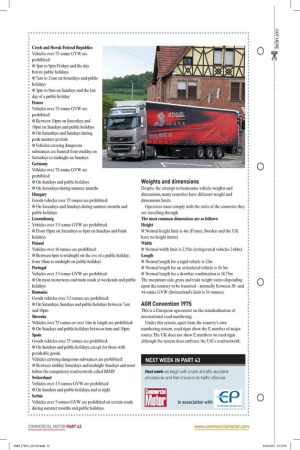Operator CPC Part 42
Page 22

Page 23

If you've noticed an error in this article please click here to report it so we can fix it.
We've reached week 42 of our Operator CPC guide and conclude our topic on traffic regulations by looking at the international parameters
Operators and drivers must ensure they are familiar with the rules and regulations for each country they have to travel through, because failure to comply could result in delays and the driver/ operator being fined. Some countries issue on-the-spot fines.
Like the UK, speed limits vary depending upon the type of road and the vehicle being driven. They are normally classified as limits in built-up areas, non-restricted roads and motorways.
Most European countries will accept a UK driving licence as proof that the driver has authority to drive the type and category of vehicle, but Albania requires an International Driving Permit. Additionally, Belarus, Russia and Ukraine require a translation to accompany a UK licence.
Vehicle licensing
Vehicles used on international journeys must have a valid excise licence and an operator's licence.
Drivers on international journeys must carry the original registration document (V5) in the vehicle (a photocopy is not acceptable).
If the V5 is not available, drivers must carry a V379, which is obtainable from a Vehicle Registration Office. International registration letters
The GB sign must be displayed to the rear of all vehicles on an international journey. It must be in black lettering on a white background. Dipped headlights
Dipped headlights are required during daylight hours in Austria, Denmark, Poland and Sweden. Snow chains
In Italy, it is not compulsory for vehicles to carry snow chains all the time during winter months, but they must be available and used when necessary, or in accordance with the road signs.
In France, the use of snow chains is obligatory on all snow covered roads and when the relevant road sign `Equipements speciaux obligatoires' is displayed.
Traffic signs
Most European road signs are multinational and display the information in pictorial form in a similar fashion to the UK. However a Triorite a droite' sign indicates that motor vehicles must give way to those vehicles approaching from the right at a junction. This is normally only the case in built-up areas.
Warning triangles
All vehicles used on international journeys must carry warning triangles which should be used in the event of an accident or breakdown and placed within specified distances from the vehicle. Most European countries require one triangle, but Spain and Turkey require two.
On-the-spot fines
As mentioned previously, certain European countries impose an on-the-spot system of fines for motoring offences. The amount of the fine will depend upon the severity of the offence committed. The system includes offences for: • Contravention of drivers' hours of work • Speeding • Failing to comply with road signs • Exceeding axle, gross and train weights • Dangerous driving • Unsecure load
Movement restrictions
Certain countries impose movement restrictions, based on the vehicle's gross weight, at certain times of the year. The following countries impose movement restrictions: Austria Vehicles over 7.5-tonne GVVV are prohibited: • After 3pm Saturdays • On Sundays and public holidays Bulgaria Vehicles over 15 tonnes are prohibited: • On Saturdays, Sundays and public holidays between 8am and 9pm Croatia Vehicles over 5 tonnes are prohibited: • At weekends during summer months and bank holidays at varying times Czech and Slovak Federal Republics Vehicles over 7.5-tonne GVVV are prohibited: • 3pm to 9pm Fridays and the day before public holidays • 7am to 11am on Saturdays and public holidays • 3pm to 9am on Sundays and the last day of a public holiday France Vehicles over 7.5-tonne GVVV are prohibited: • Between 10pm on Saturdays and 10pm on Sundays and public holidays • On Saturdays and Sundays during peak summer periods • Vehicles carrying dangerous substances are banned from midday on Saturdays to midnight on Sundays Germany Vehicles over 7.5-tonne GVVV are prohibited: • On Sundays and public holidays • On Saturdays during summer months Hungary Goods vehicles over 7.5 tonnes are prohibited: • On Saturdays and Sundays during summer months and public holidays Luxembourg Vehicles over 3.5-tonne GVVV are prohibited: • From 10pm on Saturdays to 8pm on Sundays and bank holidays Poland Vehicles over 16 tonnes are prohibited: • Between 6pm to midnight on the eve of a public holiday; from 10am to midnight on public holidays Portugal Vehicles over 3.5-tonne GVVV are prohibited: • On most motorways and main roads at weekends and public holidays Romania Goods vehicles over 3.5 tonnes are prohibited: • On Saturdays, Sundays and public holidays between 7am and 10pm Slovenia Vehicles over 7.5 tonnes or over 14m in length are prohibited: • On Sundays and public holidays between 6am and 10pm Spain Goods vehicles over 7.5 tonnes are prohibited: • On Sundays and public holidays, except for those with perishable goods. Vehicles carrying dangerous substances are prohibited:
• Between midday Saturdays and midnight Sundays and must follow the compulsory road network called RIMP. Switzerland Vehicles over 3.5 tonnes GVVV are prohibited: • On Sundays and public holidays, and at night Serbia
Vehicles over 5-tonnes GVVV are prohibited on certain roads during summer months and public holidays.
Weights and dimensions
Despite the attempt to harmonise vehicle weights and dimensions, many countries have different weight and dimensions limits.
Operators must comply with the rules of the countries they are travelling through. The most common dimensions are as follows: Height • Normal height limit is 4m (France, Sweden and the UK have no height limits) Width • Normal width limit is 2.55m (refrigerated vehicles 2.60m) Length • Normal length for a rigid vehicle is 12m • Normal length for an articulated vehicle is 16.5m
• Normal length for a drawbar combination is 18.75m The maximum axle, gross and train weight varies depending upon the country to be transited — normally between 38and 44-tonne GVVV (Switzerland's limit is 34 tonnes).
AGR Convention 1975
This is a European agreement on the standardisation of international road numbering.
Under this system, apart from the country's own numbering system, road signs show the E number of major routes. The UK does not show E numbers on road signs although the system does embrace the UK's road network.
NEXT WEEK IN PART 43
Next week we begin with a look at traffic accident procedures and then move on to traffic offences.








































